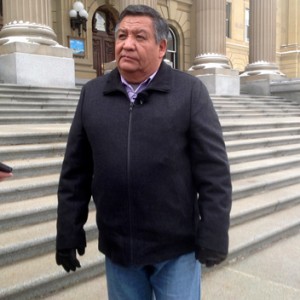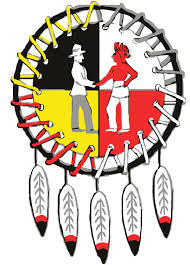Mikisew Cree First Nation Chief Steve Courtoreille was re-elected to his second term in office this past summer. And last month, he was named Grand Chief of Treaty 8, replacing former two-term Grand Chief Richard Kappo, head of the Sturgeon Lake Cree Nation and a recipient of the Queens Diamond Jubilee Medal.
Just over one month in office, the Grand Chief has been busy working to improve the stance of Treaty 8 and deal with the numerous issues facing all First Nations within Treaty 8 territory. To accomplish these goals Chief Courtoreille is working with other Chiefs in the treaty region and meeting with Alberta’s new government leader, Premier Jim Prentice, who has also assumed the position as Minister of Aboriginal Relations.

Mikisew Chief Steve Courotrielle is now Grand Chief of Treaty 8 (Alberta) Photo and article by John Copley
The Grand Chief, who already has plenty on his plate, was recently forced to comment on “a disrespectful act of vandalism” that took place just days after a team of Treaty 8 workers erected a nearly a dozen signs (Entering Treaty 8 Territory) throughout the northwest and northeast sectors of the province to highlight Treaty 8 territory and the vast region that it encompasses.
One of the signs, which has been set up on Highway 63, near Plamondon, Alberta, on Friday, November 14, was cut down and sawn in half and found by a crew of highway maintenance workers three days later, on Monday, November 17. Treaty 8 staff checked with the contractor for the region and was assured that no work was being done or had been done in that area during the previous week.
“My staff,” noted Grand Chief Courtoreille, “had worked very hard to ensure that the rules were followed, with all the necessary permits in place before it was put up. It took more hours of work to put up than it actually stayed up, and the Chiefs aren’t happy.”
Chief Courtoreille also pointed out that the sign simply stated an historical fact: “it marked out the actual borders of the Treaty No. 8 Territory and is becoming a symbol of pride for people in Treaty No. 8.
“Our Elders have told us over and over that Treaty No. 8 was a Treaty of peace and friendship, to have a sign acknowledging our Traditional Treaty Territory destroyed is not a good way to bring people together.”
He promised to have the sign replaced, noting that “this is too important to let something like this deter us.”
Treaty 8 was signed on June 1, 1899 and was the eighth treaty signed by Canada’s First Nations and Queen Victoria, then the Queen of England. Treaty 8 was the most comprehensive treaty ever signed and encompassed a land mass that included nearly 522,000 miles (840,000 km), and home to 39 First Nation (24 in Alberta) communities. Treaty 8 territory embraces the areas of northern Alberta, northwestern Saskatchewan, northeastern British Columbia, and the southwest portion of the Northwest Territories.
During past few years, and particularly under the unscrupulous reign of Allison Redford and the do-nothing reign of Ed Stelmach, First Nations in Alberta, particularly those (but not limited to) in the northeast sector of the province, have had little if any input into the industrial growth that has taken place in the region or any say in the environmental monitoring and environmental protection of the land and water that First Nations need to sustain themselves. Cancer rates are high and the types of cancers being developed are consistent with the toxins found on the land and in the water, much of which comes as a direct consequence of oil sands development. Government spokespersons have claimed that the water is fine and the land unharmed but those facts fly in an opposite direction to those of Dr. David Schindler, a member of the University of Alberta’s Biological Sciences Department. In several studies he’s undertaken in the region of Fort Chipewyan during the last few years the well known and highly respected scientist has found significant amounts of contamination and high levels of toxins.
Despite the finding the Alberta Government did nothing, except to say that their scientists found nothing unusual. Ditto for the cancer rates and kinds of cancer found in residents in the same area. The government remained in denial and even had the nerve to charge Ft. Chipewyan doctor John O’Conner when he raised the alarm and called the situation on of “crisis.” The charges were later dropped but that didn’t stop Dr. O’Conner from taking the matter even further. He recently testified in front of the United States Congress and assured them that the high rate of arsenic and mercury found in and around the community of Fort Chipewyan is indeed played a role.
“These types of toxins,” he assured, “have been associated with cancer and with the types of cancer that we are finding in Fort Chipewyan.”
Premier Jim Prentice may be the type of Premier that listens to Albertans and places a priority on the needs of the province’s Aboriginal communities; only time will tell, but he is moving in the right direction if he follows through on recent talks he’s had with First Nations leaders. That meeting took place on December 5th when Prentice met in Edmonton with the Chiefs of Treaties 6, 7 and 8. Following the meeting the Chiefs expressed “cautious optimism” and remain hopeful that the relationship they develop with the former federal Minister of Indian Affairs and Northern Development is much better and far more productive than it was with Alberta’s Conservative government under the reign of former Premier Allison Redford.
Chief Courtoreille has a number of priorities, including the challenges he faces in his new role as Treaty 8 Grand Chief. These priorities, he noted, include creating relationships with those in new positions – such as a new National Chief (Perry) Bellegarde (“to acquaint him directly with the priorities of the Treaty 8 First Nations of Alberta and to let him know what areas we may be looking for his support/assistance”) and the new Premier of Alberta,” who he hopes will act in good faith with all of Alberta’s First Nation leaders and communities.
Chief Courtoreille said that he will seek endorsement from Treaty 8 Chiefs before “advocating on issues with the provincial and federal government” on their behalf. “This involves identifying what the important issues are, collectively – and then being given the directive on how to move ahead with them.”
The most important issue facing Treaty 8 today, he said “is access to quality education and healthcare for our families and our communities. In addition, having independent control in the protection and development of our lands and resources continues to be important to Treaty 8.”
After a December 5th joint meeting with Premier Prentice Chief Courtoreille said that “for all the discussion the Premier has had with the media regarding working with First Nations, it is hopeful to see a willingness to work with us. We have serious issues with consultation in this province and it sounds like he is willing to step forward with some action.
“The provincial consultation system has a history of being controversial for First Nations and the province of Alberta has tried to create a system, it has largely been imposed and created with minimal First Nations input. Premier Prentice has been in the media lately stating that the consultation needs to be reworked. If he [Premier Prentice] continues down the road he laid out today, the Treaty 8 Chiefs will do what is necessary to create a better consultation system in this province.”
He further noted that “these are changes that must be made so that everyone, First Nations and Albertans, live in prosperous, healthy communities. The one thing I can guarantee is that the Chiefs of Treaty No. 8 [Alberta] are willing to put in the work necessary to make a better consultation system, it is time and our communities need it.”
by John Copley



Be the first to comment on "Treaty 8 Grand Chief Steve Courtoreille is embracing the challenges"